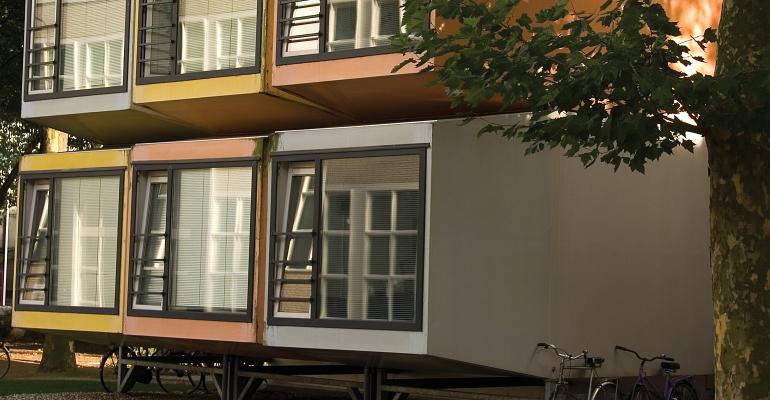Commercial real estate experts forecast increasing demand for modular construction in the healthcare, industrial, education and multifamily sectors.
“If modular goes mainstream, more manufacturing facilities will be needed to meet the demand for modular buildings,” says Mark Skender, CEO of Skender, a Chicago-based design and construction firm. “So, theoretically, yes, the more modular companies ramp up production, the more industrial facilities will be occupied.”
The U.S. modular construction business has doubled in size to $8 billion over the last five years, according to the Modular Building Institute, a non-profit trade association serving modular construction. Of general contractors already using modular construction, 67 percent expect modular use to increase over the next three years, 24 percent expect demand to remain the same, and none expect it to decrease, according to the U.S. Chamber of Commerce Commercial Construction Index. General contractors use modularization mostly for constructing exterior walls, building superstructures and fulfilling mechanical, electrical and plumbing requirements. Around 69 percent of general contractors in the Northeast use modular components, leading the rest of the United States. Contractors in the South use the least of these modular components, at around 24 percent.
“It’s booming,” says Skender. “We’re very early in the utilization of modularization, and the emerging firms are forming various strategies and approaches. As more people understand the potential for industry disruption, it will become much more common.”
Hotel chain Marriott plans to open the world’s tallest modular hotel in New York City in late 2020, after securing a $65 million loan from Arizona-based Avana Capital in April 2019.
“In order to replicate something on a modular basis, there has to be a level of similarity,” says Nick Campisano, CEO of Campisano Capital, a real estate and venture capital firm. “There’s a start-up cost associated with producing any individual footprint for a module. So, you want something that is repeated ultimately. Any time you have a lot of the same units, then there are going to be efficiencies through going modular.”
But securing loans for modular construction, such as the $65 million loan to Marriott, is challenging for developers. First, modular construction requires a significant upfront deposit for building materials. This totals around 25 percent of total construction cost typically, according to Ethan Schelin, president of Virtua Credit, a commercial real estate advisory and investment firm.
“So, from a lender’s perspective, that’s really awkward. You are spending a lot of money for materials that aren’t at the job site… and having them shipped to the factory,” says Schelin. “It makes the lender feel a lot more exposed financially than they would on a traditional construction project... It can be a little scary for the lender.”
Rectifying mistakes can also be more difficult once the components are delivered to the construction site. Around 90 percent of contractors reported their “modular construction process was either not effective or needed improvement,” and that modular construction delivers 0 percent to 5 percent in savings rather than the expected 5 percent to 10 percent compared to the traditional construction method, according to a 2019 JLL construction outlook report.
Shipping completed modules from the factory to the job site can be another nuisance, according to Schelin. For a 120-room hotel, countless truck trips are needed to deliver all the pieces to the site for assembly. This process is usually outsourced to a trucking company, but is yet another level for a prospective lender to get comfortable with.
“The reality is that execution can be difficult,” says Carlos Serra, managing director and head of the project and development services business for JLL in the U.S. Southwest region. “We see misperceptions about the manufacturing and construction approach, and a lack of transparency about how modules are manufactured and assembled. To mitigate problems down the road, developers and [general contractors] should thoroughly research their potential modular manufacturer partners.”
On a direct construction cost basis, modular construction is not cheaper than traditional construction. However, modular building can shorten construction schedules by up to 30 percent, according to Campisano. This means the revenue and occupancy stage can begin much sooner, accelerating investment returns.
“For revenue-generating properties such as rental housing or hotels, you cannot look at the nominal cost to build in isolation,” says Serra. “If the project can be completed four months quicker than conventional construction methods, even if the construction costs are similar, the ability to generate revenue earlier will often outweigh the initial capital cost disparities.”
Off-site construction in a controlled environment also addresses rising labor costs and the low supply of qualified construction professionals. Around 88 percent of contractors are concerned about the cost of skilled labor, and around 95 percent of contractors are concerned about whether workers have adequate skill levels, according to a 2019 U.S. Chamber of Commerce Commercial Construction Index report.
Modular construction is going to “trend towards nearly 100 percent market share of all large commercial projects,” says Campisano. “It is, without a doubt, the way of the future.”





